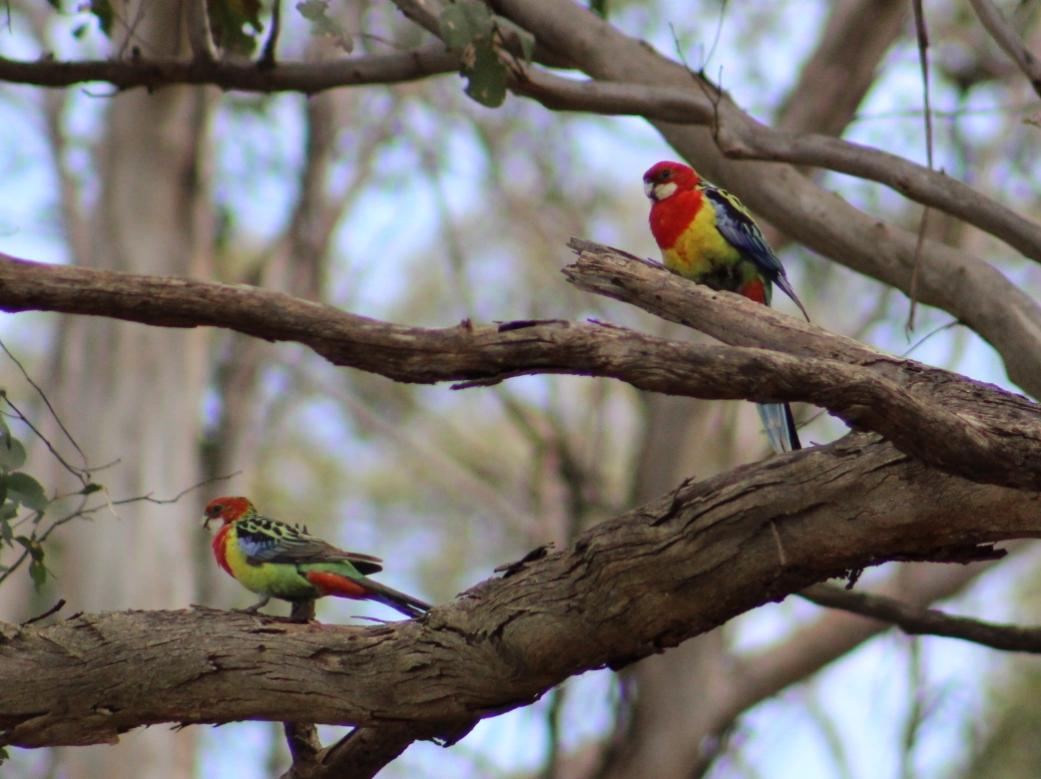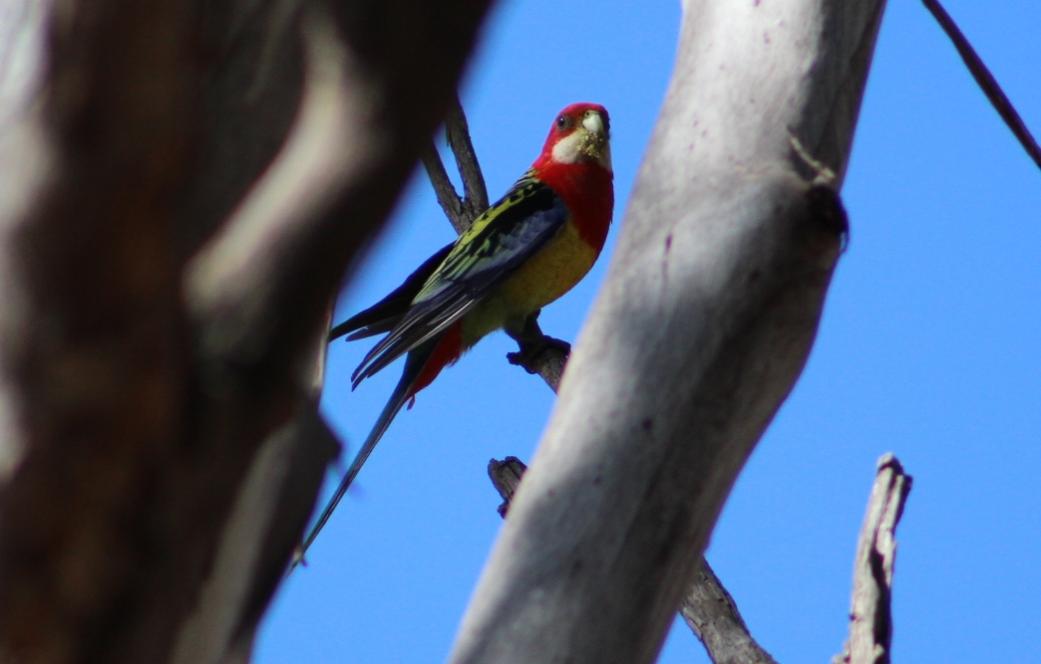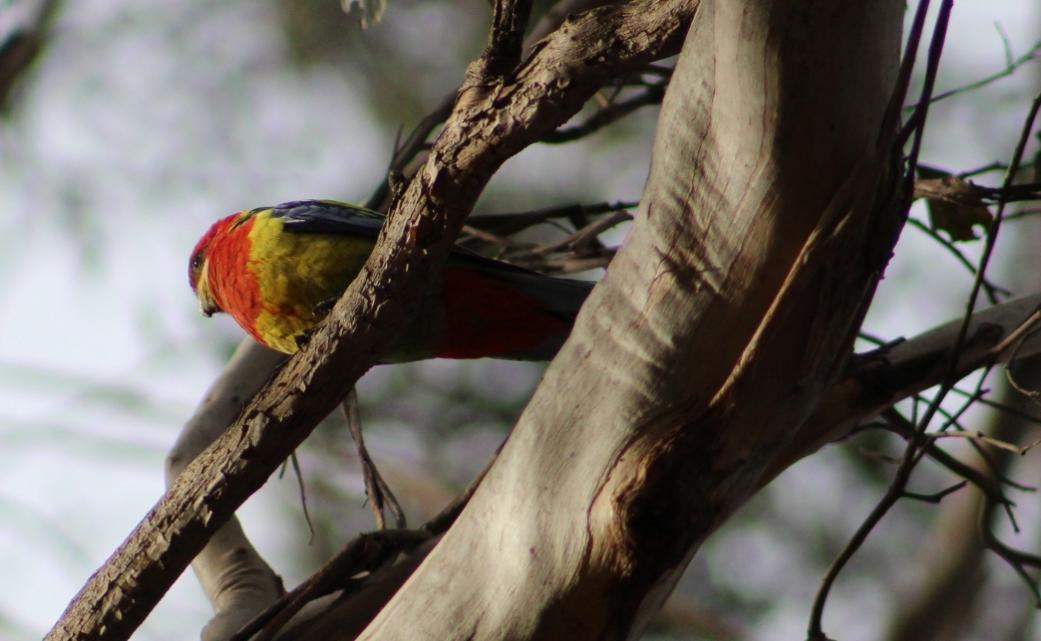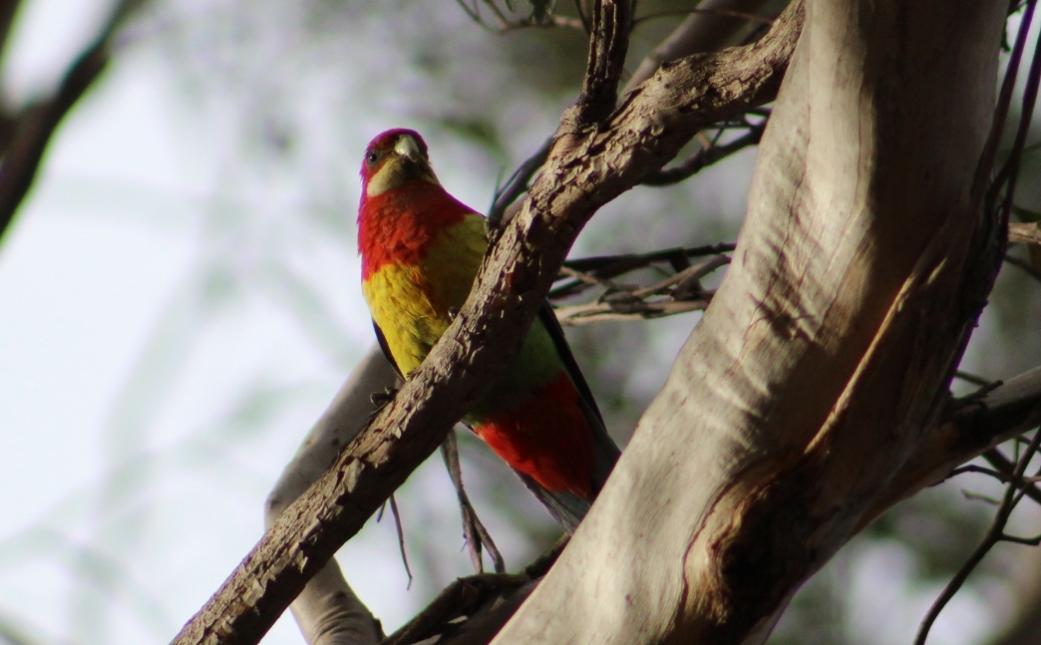May 12 - 18, 2013: Issue 110
Eastern Rosella
 This Eastern Rosella was photographed during the week in northern Pittwater, feeding on the ground on grass seeds. A stunning coloured small parrot, our bush and trees beside our waterways once teemed with these birds and their many cousins. The Rosella is named in Indigenous dreamtime legends as among the first of birds to have sung here, and signifies true love or lifelong commitment in the Jenolan Caves region and is called ‘Bur-oo-lit’ in the Kutthung, or Kattang, dialect of Australian Aborigines living along the southern bank of the Karuah river and the south shore of Port Stephens, New South Wales. The name ‘rosella’ stems from early settler’s naming of a bird common to the Rose Hill area.
This Eastern Rosella was photographed during the week in northern Pittwater, feeding on the ground on grass seeds. A stunning coloured small parrot, our bush and trees beside our waterways once teemed with these birds and their many cousins. The Rosella is named in Indigenous dreamtime legends as among the first of birds to have sung here, and signifies true love or lifelong commitment in the Jenolan Caves region and is called ‘Bur-oo-lit’ in the Kutthung, or Kattang, dialect of Australian Aborigines living along the southern bank of the Karuah river and the south shore of Port Stephens, New South Wales. The name ‘rosella’ stems from early settler’s naming of a bird common to the Rose Hill area.
Like so many of our colourful birds this genus was seen as both a pest and a crop to be harvested and sent overseas for sale during the early stages of European history in Australia. Although a more conscious mindset now exists, regular reports of bird smugglers point to a constant need for vigilance in looking after all our native birds.
During the week witnessing one dog walker allowing her kelpie to chase an Australian Ibis from its field beside local wetlands underlines that locally and nationally we are still not savvy to what makes the world beautiful or the sentient rights of all other beings.
A sample of our progression to ‘enlightenment’ or basic intelligence is below for your interest.
 The Eastern Rosella (Platycercus eximius) is a rosella native to southeast of the Australian continent and to Tasmania. Named by George Shaw in 1792, it is sometimes considered a subspecies of the Pale-headed Rosella (P. adscitus). The term White-cheeked Rosella has been used for a species or superspecies combining the Pale-headed and Eastern forms. Hybrids of the two taxa have been recorded where their ranges meet in northeastern New South Wales and southeastern Queensland. Three subspecies of Eastern Rosella are recognised:
The Eastern Rosella (Platycercus eximius) is a rosella native to southeast of the Australian continent and to Tasmania. Named by George Shaw in 1792, it is sometimes considered a subspecies of the Pale-headed Rosella (P. adscitus). The term White-cheeked Rosella has been used for a species or superspecies combining the Pale-headed and Eastern forms. Hybrids of the two taxa have been recorded where their ranges meet in northeastern New South Wales and southeastern Queensland. Three subspecies of Eastern Rosella are recognised:
P. e. eximius, Victoria and southern New South Wales. Black feathers on the back have green margins. Rump is pale green.
P. e. elecica, northeast New South Wales and southeast Queensland. In the male the black feathers on the back have golden-yellow margins, and greenish-yellow in the female. The rump is bluish-green. This subspecies is also called the Golden-mantled Rosella, often abbreviated to GMR.
P. e. diemenensis, eastern Tasmania. White cheek patches are larger and the red on the head is darke
The Eastern Rosella has a red head and white cheeks. The beak is white and irises brown. The upper breast is red and the lower breast is yellow fading to pale green over the abdomen. The feathers of the back and shoulders are black, and have yellowish or greenish margins giving rise to a scalloped appearance that varies slightly between the subspecies and the sexes. The Eastern Rosella mainly feeds on the ground, especially amongst grasses in lawns, pastures and other clearings. Also feeds in trees and bushes. Main dietary items include: seeds, fruits, buds, flowers, nectar and insects. The Eastern Rosella uses one of its feet (usually the right foot) to hold food when eating on the ground or perched on a tree.
Breeding occurs in spring and early summer and up to seven white eggs are laid in tree hollows. Eastern Rosellas mate for life. The female chooses and prepares the nesting site, usually a hollow in a eucalypt tree (but will sometimes use a nest-box or other artificial site). Eggs are laid on a decayed wood bed and the female incubates the eggs while the male regularly feeds her. The young may be fed for a while after they fledge.
They are sometimes kept as a pet due to their beautifully coloured plumage. Intelligent creatures, which can be trained to whistle a wide repertoire of tunes and may even learn to speak a few words or phrases, Rosellas make good companion parrots; however, they require a great deal of attention and many toys to satisfy their need for social interaction and mental stimulation.
From Birdlife Australia and Eastern Rosella. (2013, April 10). In Wikipedia, The Free Encyclopedia. Retrieved 22:00, May 7, 2013, from http://en.wikipedia.org/w/index.php?title=Eastern_Rosella&oldid=549636258
 JURY WAS NOT UNANIMOUS
JURY WAS NOT UNANIMOUS
THE July meeting of Pine Shire Council, with three dissentients, favored placing the Eastern Rosella (Platycercus eximlus) on the list of birds to be dealt with by the Pests Destruction Board. The bird is reported to be responsible for loss of maize by allowing rain to enter the cob after it has picked at them. JURY WAS NOT UNANIMOUS. (1945, July 19). Queensland Country Life (Qld. : 1900 - 1954), p. 5. Retrieved from http://nla.gov.au/nla.news-article97092760
Rosella to be tried for life as pest for the second time in four years, the beautiful Eastern Rosella parrot, alias Plalycercus eximus, is on trial for its life.
Reason is' the parrot's alleged damage to grain crops. The Brisbane and West
Moreton Pest Board decided this week to ask the Government to declare the parrot officially a pest, and to put a price, on its head. This followed petitions presented by Councillors W.J. Smith and W.J. Wolff, and signed by grain growers who said that the amount of grain eaten and destroyed by this parrot far outweighed any value it might have as an insect-eating bird. Four years ago a similar request was made to the Government, but after hearing evidence from other shires the Government decided that insufficient proof had been given that the rosella's grain-eating proclivities outweighed its natural beauty and Insect eating capabilities. The annual report presented to the Pest Board at its meeting this week showed that in 1948 – 49 nearly £740 was paid for the destruction of the following 51,743 pests:—31,526 sparrows(at 2d. a head);2578 sparrow eggs(Id.); 8965 flying foxes (6d.) ; 3004 scrub magpies(6d.) ; 2264 bee eaters (4d.); 1698 crows (1/) ; 1679 starlings (6d.) ; and 29 starlings' eggs. The board stated that starlings and sparrows not only carried lice, but were threatening to oust native birds and insect-eaters by appropriating their nesting grounds and causing a food shortage. Rosella to be tried for life as pest. (1949, September 3). The Courier-Mail (Brisbane, Qld. : 1933 - 1954), p. 3. Retrieved from http://nla.gov.au/nla.news-article49674426
MUSEUM FEATURETTE Rosella was once Rose-hiller . The rosella parrot is generally accepted as having been a corruption of "rose-hiller"-a name early settlers applied to a very common bird in the suburb of Rosehill, NSW.
Rosella was once Rose-hiller . The rosella parrot is generally accepted as having been a corruption of "rose-hiller"-a name early settlers applied to a very common bird in the suburb of Rosehill, NSW.
The rosella is on show at the Adelaide Museum.
Rosella is now applied to a number of related long-tailed parrots, which occur in the wetter parts of Australia and Tasmania. The Adelaide rosella, the local member of the well-known red lowry (or crimson rosella) of eastern Australia, is numerous in the Mount Lofty Ranges, where greenish young ones maybe seen in flocks with brick-red colored elders. This color difference has led some laymen to think that there is more than one species of large parrot in Adelaide.
The yellow rosella is common along irrigation areas of the River Murray. The green rosella lives in Tasmania and Bass Strait islands. '" I
In the eastern States, the eastern rosella occurs as well as the red lowry, and it is also in small numbers in the Mount Lofty Ranges.
In Queensland, another species, the pale-headed or Moreton Bay rosella is a predominantly blue and yellowbird with whitish head. Northern Australia has its own :rosella, too, the mealy or northern rosella. Similar in habits to its cousins of the south, it is a black-headed bird, with much yellow in the plumage.
The smallest of the group, the western rosella, occurs in south-western Australia. It is at once distinguished by its yellow cheek patches. These are mostly blue (or white in the eastern rosella) in other species. Although rosellas do much harm: in 'certain horticultural areas' they are charming birds -and should not be molested un-less they become nuisances. They are popular cagebirds. MUSEUM FEATURETTE. (1951, April 23). Barrier Miner (Broken Hill, NSW : 1888 - 1954), p. 3. Retrieved from http://nla.gov.au/nla.news-article48639195
AN ABORIGINAL LEGEND.
(From a Correspondent of the Daily Telegraph.)Those who believe that the aborigines of Australia have had no oral traditions handed down to them are greatly mistaken, for they seem to have had a great many, and at their corrobborees or festivals they retail little else than legendary lore. From some of the more intelligent of the Hotspur and Crawford River blacks I have eliminated the meaning of several of their historical fragments, the most interesting of which appears to be "The Two Moons." They say that long ago, in the days of their first fathers, before the tarpaulins of the white fellows' ships were seen on the waters, Hotspur was a great country and very warm. In its forests roamed kangaroos bigger than bullocks, wombats fatter than white fellows' pigs, and birds whose eggs were larger than the melons of Leywhollet(sic). On its plains were abundance of sweet yams, and at all times water to boil them. There were two moons in those days-a great one which was always present, and a smaller one which occasionally hid itself-and their fathers were nearer the sun than they are ; but at length the great spirit (big master) got angry-the large moon went away, the beasts and birds died, the yams withered, and the hot springs became cold. Then jumped up a class of smaller animals, and the rosella and white cockatoo. The legend would seem to support the opinion of those who attribute an asteroidal origin to New Holland, for if such an origin was possible the earth would assume the appearance of a great moon, always present to the asteroid, while the moon performed its revolutions as at present. In the Wellington Caves, New South Wales, the remains of gigantic kangaroos and wombats have been found, which when living must have far exceeded in size those alluded to in the legend, and although no remains of the dinornis have yet been found here they are abundant in New Zealand. In 1722(sic) an aerolite, sup-posed to be nearly as large as New Holland, passed across the Pacific Ocean so near its surface that if Chimborazo had stood in the way it would have been intercepted ; and in 1728 another fell slap into the earth, and its component parts were found to be similar to those of the earth. What would appear a fatal question to the validity of the aboriginal legend would be, "Where did the water come from which supplied the boiled springs?" And unless we suppose that aqueous vapour in the fields of ether through which the asteroid passed could be condensed in sufficient quantity for that purpose, we must assume that the legend was acquired from the missionaries in the early days of the colony. AN ABORIGINAL LEGEND. (1870, September 1). Kilmore Free Press (Kilmore, Vic. : 1870 - 1954), p. 4 Edition: MORNING.. Retrieved from http://nla.gov.au/nla.news-article70055339
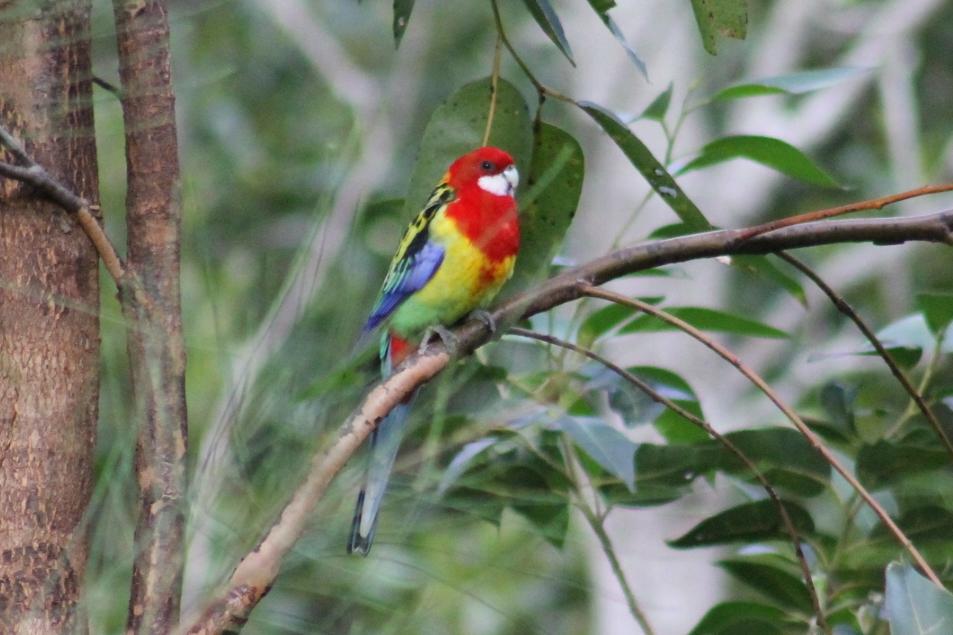
GEELONG, Tuesday: A number of New Australians were fined in Geelong City Court today for having shot native birds in a sanctuary at the You Yangs Forestry reserve. The men had shot red wattle birds and white winged choughs, which, they told, a Forestry officer, were, "good for eating." Alf Pica, Clifton st., Richmond, was fined £5 for shooting in a sanctuary, andwas ordered to pay 5/, the value of a red wattle bird he had shot, and £1/18/8 costs. Antonio Gitto, Cecil st., South Melbourne, who shot seven white-winged choughs, was fined £5 for shooting in a sanctuary, and ordered to pay 35/ and 15/ costs. Don Demarte, Cael st., North Melbourne, who shot a white-winged chough and a red wattle bird, was fined £5 and ordered to pay 10/and 15/ costs. Antonio Rizzlo, of Fitzroy, who shot five red wattlebirds, a fantail cuckoo, an eastern rosella and a crimson rosella, was fined £5 and ordered to pay 30/ and15/ costs. Leo Italiano, Peel st., North Melbourne, was fined £5 for trespassing on a sanctuary in search of native game. Mr. A. Dunbavin Butcher, Fisheries and Game Department director, last night said destruction of native birds in Victoria was one of the biggest problems facing his department. Many migrants regarded our birds as "delicacies" and killed them for food. À costly campaign had been held in migrant hostels and organisations employing migrants to explain that native birds were protected, but lt had failed. Migrants killed native birds. (1955, June 15). The Argus(Melbourne, Vic. : 1848 - 1957), p. 5. Retrieved from http://nla.gov.au/nla.news-article71888308
AUSTRALIAN BIRDS. A special reporter of the Adelaide Register, writing in that paper on the 4th of February says:
A special reporter of the Adelaide Register, writing in that paper on the 4th of February says:
Being a great lover of Australian birdsI often drop in to Mr John Foglia's shop at the east end of Rundle street to see if any new or rare specimens have come to hand. For the last few weeks the trappers have been arriving from the country with large consignments of parrots and finches, and most of the birds found their way to Mr, Foglia, as that dealer has been preparing for the large shipment which he is taking away to Europe by the S S Rhein, which will sail this afternoon. Nearly always when I left the bird shop I could not help regretting that South Australians know so little about their own beautiful native birds, and our ignorance of our own fauna is emphasized by the fact that the police seized 4000 or 5000 of Mr Foglia's birds at Port Adelaide on Friday afternoon; and then, realising that they had made a mistake, restored them and paid the dealer all expenses. It was rather childish for the police officer to remark "They are the last birds I'll seize" because he had committed a blunder.
Mr. Foglia is the largest bird dealer in Adelaide, and he has been in the trade longer than anyone else here. This afternoon I visited his premises and inspected the birds ready for shipment. They numbered about 13,500. Mr. Foglia will pick up other lots in Western Australia and at Colombo, and the total shipment will then aggregate 14,900. The dealer has secured eleven tons of room on the top deck of the German boat. This alone costs £65. The expense is heavy in other directions. For instance Mr. Foglia is taking three and a-half tons of canary seed, and the price of that is £27 10s. per ton. Crushed corn and other food is also being taken. Last year when Mr. W. Foglia, a son of Mr. J Foglia, superintended a shipment home, canary seed was only £15 per ton, so the increased expense in this item alone is about £30. The great thing is to get the birds away quickly. Last year Mr Foglia had to keep his many thousands of charges for thirteen weeks; but this year he got them right on the spot. The present consignment cost £10 a-week to keep.
The great majority of the birds comprise the pretty green and yellow shell parrot or warbling grass parrot and the bright cheerful little zebra finch. One year Mr. Foglia shipped 10,000 shell parrots, while on another occasion his son took home11,600. " I sold them all to one big dealer." he remarked, "and it took three of us three days, from seven o'clock in the morning till seven o'clock at night, to count them." The Illustrated Book of Canaries and Cage Birds, English and Foreign "gives some interesting particulars concerning the undulated grass parrakeet, another name by which this love bird is known. Mr. Gould, whose "Birds of Australia" is a monument to the memory of the naturalist and his clever wife, took the first pair of live shell parrots to England in 1840. Between 1840 and 1850 a pair of these little birds was worth from £20 to £25. About 1850 to 1855 a pair would cost about £5. Between 1855 and 1858 larger numbers of these parrakeets reached Europe, and their price sank to a couple of sovereigns. Then the importation of the birds increased enormously. The total importation of budgerigars, still another name for the bird, in London in the first six months of 1870 was over 50,000 pair, and they all found buyers. Twenty years ago Dr. Russ estimated that from 10,000 to 25,000 shell parrots were bred annually in Europe. It was then nearly as common a cage bird as the canary. More or less pure yellowbirds have been bred mostly in Belgium. Even a blue variety has occurred, and at least one breeder has, through careful selection, produced a breed of unusual size. I met a trapper the other day who told me he had caught a pure yellow shell parrot. Flying with the flock of its green companions, it looked like a beautiful yellow butterfly. Like the grass parrakeets, the zebra finches are hardy cage birds, and they breed readily in captivity. Anyone who has travelled about the country at all will remember having seen flocks of these chirping little finches. An English amateur once exhibited at the Crystal Palace a cage containing thirty-five zebra finches, the result of one season's breeding from two pairs.
 Included in the 10,000 birds are a large number of the splendid-plumaged diamond sparrows or spotted-sided finch. These birds are wonderfully distributed over the country and are invariably noted at waters by explorers. One case in the shop contained a dozen Leadbeater's or Mitchell's cockatoo. This is one of the most beautiful and elegant of the genus yet discovered; but it does not readily learn to talk. Mr. Foglia is also taking with him a fine lot of rose-breasted cockatoos, commonly called galahs, and twenty or thirty corillas, both of which varieties are capital talkers. A bird which Mr, Foglia is taking home for the first time is a bright, happy, rusty, brown pigeon, called the plumed partridge bronzewing. They come from central Australia. They should carry well and find eager buyers in England. One specimen of the little green pigeon is going over the sea, while the magnificent bronzewing and exquisite lavender-coloured crested pigeons are well represented. Included in the shipment are waxbill finches, diamond doves, bower birds (about whose playgrounds quite a story could be written), and Cape Barron geese. The last-named birds are wholly protected; but Mr. Foglia has a sworn testimony that these birds were bred in captivity.
Included in the 10,000 birds are a large number of the splendid-plumaged diamond sparrows or spotted-sided finch. These birds are wonderfully distributed over the country and are invariably noted at waters by explorers. One case in the shop contained a dozen Leadbeater's or Mitchell's cockatoo. This is one of the most beautiful and elegant of the genus yet discovered; but it does not readily learn to talk. Mr. Foglia is also taking with him a fine lot of rose-breasted cockatoos, commonly called galahs, and twenty or thirty corillas, both of which varieties are capital talkers. A bird which Mr, Foglia is taking home for the first time is a bright, happy, rusty, brown pigeon, called the plumed partridge bronzewing. They come from central Australia. They should carry well and find eager buyers in England. One specimen of the little green pigeon is going over the sea, while the magnificent bronzewing and exquisite lavender-coloured crested pigeons are well represented. Included in the shipment are waxbill finches, diamond doves, bower birds (about whose playgrounds quite a story could be written), and Cape Barron geese. The last-named birds are wholly protected; but Mr. Foglia has a sworn testimony that these birds were bred in captivity.
The parrakeets in the collection are the grass or blood rump, the many-coloured, the blue bonnet or crimson bellied, Victorian rosella, Adelaide parrakeet, scrub rosella, the rock pebler, the blue-banded grass, the cockatiel, and five pairs of the exceedingly rare and exquisitely tinted Bourke's grass parrakeet. The last-named was discovered by Major Sir Thomas Mitchell on the banks of the Bogan, New South Wales. With the exception of the Princess Alexandra parrakeet, this is the most difficult bird to procure, and it is much sought-after in England. Mr. Foglia expects to pick up a number of Port Lincoln parrots in Western Australia.
 Mr. W. Foglia look a pair of Prince Alexandra parakeets to England last year, and they were subsequently purchased by Baron Rotshchild. There are not more than twenty of these birds in captivity. About the finest specimen in South Australia is one in the possession of Mr. K. K. Thomas. This was one of the birds the late Mr. C. Winnecke brought to Adelaide, and one of the few survivors of that lot. Mr. Thomas obtained the parrakeet when it was a fledgling and he has had it for ten years. It has been fed on canary seed, mixed parrot food, and a little thistle. Mr. F. E. Benda, of the Northen Territory Department, has a hen bird (the cock died) which has laid several eggs. Mr. Grundy, of the Mount Torrens Cyanide Works, has two specimens, and Mr. L. C. E. Gee four birds. The only specimen that came under Gould's notice was shot at Howell's Ponds by Stuart's expedition and was brought back by Sir F. G. Waterhouse. Gould named it after the then Princess of Wales, now Queen of England. In the December number of the Public Service Review Mr Lionel Gee describes a trip he took along the Hale River in company with a companion from Trinity College Cambridge and Fred, a black boy.
Mr. W. Foglia look a pair of Prince Alexandra parakeets to England last year, and they were subsequently purchased by Baron Rotshchild. There are not more than twenty of these birds in captivity. About the finest specimen in South Australia is one in the possession of Mr. K. K. Thomas. This was one of the birds the late Mr. C. Winnecke brought to Adelaide, and one of the few survivors of that lot. Mr. Thomas obtained the parrakeet when it was a fledgling and he has had it for ten years. It has been fed on canary seed, mixed parrot food, and a little thistle. Mr. F. E. Benda, of the Northen Territory Department, has a hen bird (the cock died) which has laid several eggs. Mr. Grundy, of the Mount Torrens Cyanide Works, has two specimens, and Mr. L. C. E. Gee four birds. The only specimen that came under Gould's notice was shot at Howell's Ponds by Stuart's expedition and was brought back by Sir F. G. Waterhouse. Gould named it after the then Princess of Wales, now Queen of England. In the December number of the Public Service Review Mr Lionel Gee describes a trip he took along the Hale River in company with a companion from Trinity College Cambridge and Fred, a black boy.
 Right: Magpie lark, Grallina cyanoleuca
Right: Magpie lark, Grallina cyanoleuca
Incidentally Mr Gee went to see if he could procure some Princess Alexandra parrakeets(above). Having described Claraville, Mr. Gee says,: "The usual cluster of aborigines, is in evidence, and we interview Jemima. Jemima is a stout, comely aboriginal lady of a certain age; but she has influence with the other natives and knows the habits of birds. Therefore, to Jemima we turn with a benign and philanthropic manner suggestive of benefits to come, for we want to get some young Alexandra parrakeets. ' Which way that one long-tail fellow sit down, Jemima ? 'we asked. ' Long-tail fellow sit down all about this time; him make 'em nest same time this away,' and Jemima points to the northward with her chin – blacks always point with the chin. ' You get 'emme little fellow ? ' we asked. Me get 'cmall right,' she said. ' Me give it plenty tucker, plenty bacca,' we said. ' All right; me get em nother day,' replied Jemima. And so the bargain was completed, and, it may be mentioned, faithfully kept on both sides. The birds do not nest in the Hals itself: but towards the head of its northern tributaries, and the sable Diana and her satellites had fortnight's 'walkabout' before they secured the specimens, which afterwards, with infinite pains and trouble, were triumphantly carted down to Adelaide. The boss of Claraville gave us some interesting particulars regarding those birds. They are irregular in their visits; that is, they do not come to the ranges at all in bad seasons; but when the seasons are good and water and seeds are abundant, they appear regularly about the middle of September, and disappear again about the middle of December; and even when they are plentiful (according to the blacks) white men do not often see, them -a fact which we afterwards verified. Trinity said that they migrated between Java and central Australia; bur the scribe, remembering the opinions of ornithological experts in Adelaide - that the birds do not leave Australia- made a statement to that effect. Trinity became incoherently profane. The scribe derided. Trinity was understood to convey amid 'language' that he had actually seen the birds in Java. The scribe humbly apologised and suddenly remembered that Charley Winnecke' (who has been called from labour) had once in conversation with him surmised that the birds came from tropical islands to the north-west."
In the way of animals Mr. Foglia is taking kangaroos, euros, wallabies, opossums, bandicoots, and native squirrels. Mr, Foglia goes first to Belgium. He expects to have his biggest sale at Antwerp. AUSTRALIAN BIRDS. (1905, March 1). Morning Bulletin(Rockhampton, Qld. : 1878 - 1954), p. 3. Retrieved from http://nla.gov.au/nla.news-article53034501
Photos by A J Guesdon, May, 2013 and October 2017.
